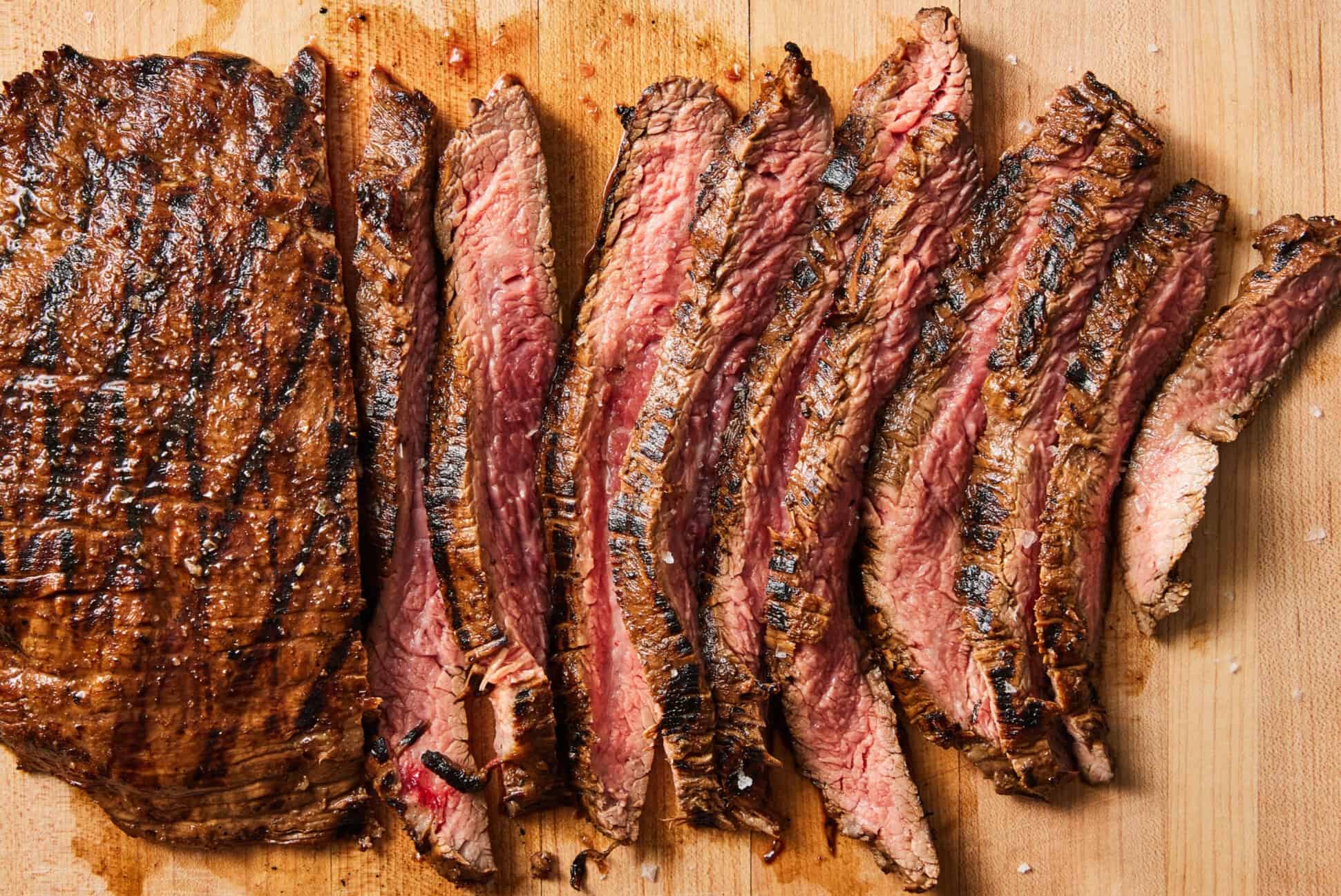Introduction
Flank steak is a flavorful and lean cut of beef that has gained popularity for its versatility in cooking and its nutritional value. Sourced from the abdominal muscles of the cow, this cut is known for its rich taste, low fat content, and high protein concentration. Whether you’re grilling, broiling, or marinating it for tacos or stir-fry, flank steak offers more than just taste—it’s also packed with important nutrients. Understanding flank steak nutrition facts can help you make better dietary choices, especially if you are aiming for a high-protein, low-carb meal plan.
Nutritional Overview (Per 100g Serving)
Flank steak is commonly praised for its lean profile, and the nutritional breakdown reflects that. Here’s a detailed table showing the nutritional values of raw flank steak trimmed to 0″ fat per 100 grams:
| Nutrient | Amount (Raw, 100g) | Amount (Cooked, 100g) |
|---|---|---|
| Calories | 141 kcal | 192 kcal |
| Protein | 21.6 g | 28 g |
| Total Fat | 5.5 g | 8 g |
| Saturated Fat | 2.1 g | 3.1 g |
| Monounsaturated Fat | 2.0 g | 3.0 g |
| Polyunsaturated Fat | 0.2 g | 0.3 g |
| Cholesterol | 33 mg | 79 mg |
| Carbohydrates | 0 g | 0 g |
| Sodium | 55 mg | 56 mg |
| Iron | 1.6 mg | 2.2 mg |
| Potassium | 340 mg | 370 mg |
| Calcium | 24 mg | 26 mg |
As evident from the table, flank steak is rich in protein and virtually free of carbohydrates, making it an excellent option for ketogenic or low-carb diets. The fat content is moderate and mostly made up of healthy fats like monounsaturated fat, especially when the cut is trimmed of visible fat.
Macronutrient Profile
Protein
Flank steak stands out for its high protein content. With about 28 grams of protein in a cooked 100g serving, it contributes significantly to muscle repair, growth, and overall metabolism. It’s a go-to protein source for athletes, fitness enthusiasts, and individuals trying to maintain a healthy weight without compromising on taste.
Fats
Despite being a red meat, flank steak contains a manageable amount of fat. The saturated fat levels are moderate, and a significant portion of the fat comes from healthier monounsaturated fats. This balance helps support heart health when consumed in moderation and prepared using healthy cooking methods.
Carbohydrates
One of the key flank steak nutrition facts is its zero-carb content. It naturally contains no carbohydrates, sugars, or dietary fiber, making it suitable for those on paleo, low-carb, or diabetic-friendly meal plans.
Micronutrient Content
In addition to macronutrients, flank steak also provides a variety of essential vitamins and minerals:
- Iron – Vital for oxygen transport in the blood and preventing anemia.
- Zinc – Supports immune function and wound healing.
- Phosphorus – Important for strong bones and teeth.
- Vitamin B12 – Essential for red blood cell formation and neurological function.
- Niacin (Vitamin B3) – Plays a key role in energy metabolism and skin health.
- Vitamin B6 – Important for protein metabolism and cognitive development.
The presence of these nutrients makes flank steak a powerhouse for promoting overall wellness, especially for individuals with increased nutritional needs.
Health Benefits of Flank Steak
Understanding flank steak nutrition facts highlights why it can be a healthy part of your diet when consumed appropriately. Some of the key health benefits include:
1. Muscle Growth and Repair
The high protein content aids in building and repairing muscle tissues, especially after physical activity or injury recovery.
2. Weight Management
Thanks to its low carbohydrate and high satiety profile, flank steak helps keep you full for longer, reducing the urge to snack excessively.
3. Heart Health Support
When prepared without excessive fats and oils, flank steak’s lean nature, combined with its supply of essential fatty acids, can contribute to heart health.
4. Iron Boost
For people suffering from iron deficiency anemia, flank steak offers an easily absorbed form of iron (heme iron), which helps improve blood health.
5. Energy Production
B vitamins, particularly B6 and B12, help convert food into usable energy and maintain healthy brain and nerve function.
Cooking Tips for Nutritional Preservation
To make the most of the flank steak nutrition facts, how you cook the steak matters. Avoid frying or overcooking, as this can increase unhealthy fat content and reduce nutrient levels. Here are some healthier cooking methods:
- Grilling: Enhances flavor without added fat.
- Broiling: Retains tenderness and reduces fat content.
- Sous-vide: Maintains nutrients and moisture perfectly.
- Stir-frying (with minimal oil): A quick and healthy way to retain flavor and texture.
Always slice flank steak against the grain to maximize tenderness.
Comparison with Other Cuts of Beef
Here’s how flank steak compares nutritionally with other popular beef cuts (per 100g, cooked):
| Cut | Calories | Protein | Fat | Carbs |
|---|---|---|---|---|
| Flank Steak | 192 | 28g | 8g | 0g |
| Ribeye | 291 | 24g | 23g | 0g |
| Sirloin | 207 | 26g | 9g | 0g |
| Tenderloin | 267 | 26g | 18g | 0g |
Clearly, flank steak offers a lower calorie and fat option compared to more marbled cuts like ribeye or tenderloin, while still delivering a solid protein punch.
Is Flank Steak Good for Your Diet?
Absolutely! When you look at the flank steak nutrition facts, it becomes evident that it can be a nutritious addition to most balanced diets. It supports muscle-building goals, weight loss plans, and nutrient-rich eating habits. However, moderation is key—excessive consumption of red meat can have drawbacks, so it’s best enjoyed 1–2 times a week alongside plenty of vegetables and whole grains.
Conclusion
Flank steak is much more than just a flavorful beef cut—it’s a nutrient-dense, high-protein food that fits into a variety of healthy eating plans. From its low fat and calorie content to its rich supply of iron, B vitamins, and essential minerals, the flank steak nutrition facts show that this cut holds a lot of nutritional value. Choosing healthier cooking methods and pairing it with wholesome side dishes can make flank steak a staple in your diet without compromising your health goals.
FAQs
1. Is flank steak high in calories?
No, flank steak is relatively low in calories, especially when compared to other beef cuts. A 100g cooked serving has about 192 calories.
2. How much protein is in flank steak?
A 100g cooked serving of flank steak contains approximately 28 grams of protein, making it an excellent source for muscle support.
3. Does flank steak have carbs?
No, flank steak is naturally free of carbohydrates, making it ideal for keto or low-carb diets.
4. Is flank steak good for weight loss?
Yes, thanks to its high protein and low fat profile, flank steak can help keep you full longer, aiding in weight management.
5. What’s the best way to cook flank steak to retain nutrients?
Grilling, broiling, or sous-vide methods are recommended to preserve nutrients without adding unnecessary fats or oils.
Related Articles
The Connection Between Allergies and Skin Conditions
How to Find a Reliable Urgent Dental Care Provider Near You
How To Overcome Obstacles in Your Weight Loss Journey
How Deep Vein Thrombosis Affects Your Circulatory Health and What You Can Do About It









Leave a Reply